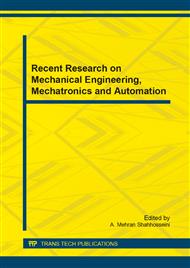p.109
p.114
p.119
p.127
p.133
p.138
p.143
p.147
p.154
Molecular Dynamics of the Properties of Fluid Film Induced by Fluid-Solid Interaction Potential Strength in Wedge Nanochannel
Abstract:
Molecular dynamics method is applied to study the influence of fluid-solid interaction potential on the properties of fluid film in wedge nanochannel. The pressure and density are studied for a variety of potential interaction strength between the liquid and the solid. The impact of potential interaction strength between the liquid and the solid on the pressure is limitation. The density along y direction is affected by the potential interaction strength. As the potential interaction strength is weak, the density of liquids can be affected easily.
Info:
Periodical:
Pages:
133-137
Citation:
Online since:
July 2014
Authors:
Price:
Сopyright:
© 2014 Trans Tech Publications Ltd. All Rights Reserved
Share:
Citation:


